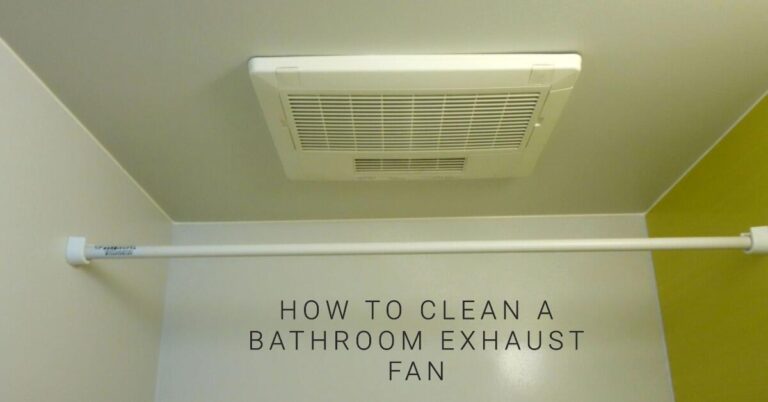Fitting bathroom extractor fans is essential to keep your bathroom fresh, dry, and odor-free. A bathroom extractor fan is a device that removes moist and stale air from your bathroom and vents it outside. This helps prevent mold, mildew, peeling paint, and other moisture-related problems in your bathroom. But how do you fit bathroom extractor fans? What are the different types of fans, and how do you choose the right one for your bathroom? What tools and materials do you need, and what steps are involved?
This blog post will answer all these questions and more. We will show you how to fit bathroom extractor fans easily. We will also provide tips and tricks to make the process smoother and safer.
By the end of this post, you can fit a bathroom extractor fan like a pro and enjoy a cleaner and healthier bathroom. Let’s get started!
- What are the Different Types of Extractor Fans for Bathrooms?
- How to Choose the Right Size and Power of Fan for Your Bathroom?
- What Tools and Materials Do You Need to Fit a Bathroom Extractor Fans?
- How to Fit Bathroom Extractor Fans: Step by Step
- How to Fit Bathroom Extractor Fans: Tips and Tricks
- Conclusion
- Frequently Asked Questions
- Resources
What are the Different Types of Extractor Fans for Bathrooms?
You must know what fan you need before you fit bathroom extractor fans. There are three main types of extractor fans for bathrooms: axial, centrifugal, and inline.
- Axial fans: These are the most common and cheapest type of fans. They connect directly to an external wall or window and are used when the air doesn’t need to be moved long distances. They are suitable for small bathrooms close to an external wall or window.
- Centrifugal fans: These are more powerful and quieter than axial fans. They are designed for bathrooms not close to an external wall or window (over 1.5m away). They use a spinning wheel to create a strong airflow that can travel through long ducts. They are suitable for large bathrooms or bathrooms with multiple fixtures.
- Inline fans: These are mounted in a remote location (often the attic) and connect to an intake grille on the bathroom ceiling and an exhaust vent on the roof or wall. They are the most discreet and flexible type of fans, as they can simultaneously serve more than one bathroom. They are suitable for any size or layout of the bathroom.
How to Choose the Right Size and Power of Fan for Your Bathroom?
The size and power of your fan depend on the size of your bathroom and the length of your ductwork.
The size of your bathroom determines the airflow rate or cubic feet per minute (CFM) your fan needs. The airflow rate measures how much air the fan can move in one minute. The bigger the bathroom, the higher the CFM rating you need.
Generally, you need at least 1 CFM per square foot of bathroom space. For example, if your bathroom is 80 square feet, you need a fan with at least 80 CFM. However, getting a slightly larger fan than a smaller one is better, as it will be more effective and quieter.
The length of your ductwork determines the static pressure or inches of water column (WC) that your fan needs to overcome. The static pressure measures how much resistance the air faces when moving through the ducts. The longer and more curved your ducts are, the higher the static pressure you need.
Generally, you need at least 0.25 WC per 10 feet of straight ductwork. For example, if your ductwork is 20 feet long, you need a fan with at least 0.5 WC. However, you must add 0.1 WC for each bend or elbow in your ductwork.
To find out the exact size and power of the fan you need for your bathroom; you can use online calculators or consult with professionals.
What Tools and Materials Do You Need to Fit a Bathroom Extractor Fans?
To fit a bathroom extractor fan, you will need the following tools and materials:
- A bathroom extractor fan of your choice
- A drill with bits
- A hole saw or jigsaw.
- A screwdriver
- A wire stripper
- A circuit tester
- Wire connectors
- Duct tape or HVAC tape
- Ductwork (if not included with the fan)
- A vent cap or hood (if not included with the fan)
- A ladder
- Safety goggles
- Gloves
How to Fit Bathroom Extractor Fans: Step by Step
Now that everything is ready, it’s time to fit your bathroom extractor fan. The exact steps may vary depending on the type and model of your fan, but here is a general overview:
Step 1: Turn off the power
Before working with electrical wires, turn off the power supply to your bathroom at the main circuit breaker panel. Use a circuit tester to confirm that no electricity flows in the wires.
Step 2: Cut a hole in the ceiling or wall
Next, you need to cut a hole in the ceiling or wall where you want to install the fan. The hole should be slightly larger than the fan housing. Use a drill to make a pilot hole, then use a hole saw or jigsaw to cut out the hole. If installing a wall-mounted fan, cut the hole near an external wall or window.
Step 3: Attach the fan housing
Then, you need to attach the fan housing to the ceiling joist or wall stud. Use screws to secure the housing in place. Make sure the housing is level and flush with the surface.
Step 4: Connect the ductwork
Next, you need to connect the ductwork from the fan to the vent cap or hood. The ductwork should be as short and straight as possible, with minimal bends or elbows. Use duct or HVAC tape to seal the joints and prevent air leaks.
Step 5: Install the vent cap or hood
Then, you must install the vent cap or hood on the roof or wall to vent the air outside. The vent cap or hood should have a flap or damper that prevents backdrafts and insects from entering. Use screws to secure the vent cap or hood in place. Make sure the vent cap or hood is facing away from prevailing winds.
Step 6: Connect the wires
Next, you need to connect the wires from the fan to the power supply and switch. The wiring may vary depending on the type and model of your fan, but here is a general guide:
- If your fan has a plug, plug it into an outlet in your bathroom.
- If your fan has wires, strip about half an inch of insulation from each wire using a wire stripper.
- Connect the black wire from the fan to the black wire from the power supply using a wire connector.
- Connect the white wire from the fan to the white wire from the power supply using a wire connector.
- Connect the green or bare wire from the fan to the green or bare wire from the power supply using a wire connector.
- If your fan has a light, heater, or humidity sensor, follow the manufacturer’s instructions for wiring them.
- Tuck all the wires neatly inside the fan housing and secure them with wire connectors.
Step 7: Attach the fan cover
Finally, you need to attach the fan cover over the fan housing. The cover may snap in place or have clips or screws holding it. Make sure the cover is aligned with the fan housing and fits snugly.
How to Fit Bathroom Extractor Fans: Tips and Tricks
Here are some tips and tricks that can help you fit a bathroom extractor fan more easily and safely:
- Before you buy a bathroom extractor fan, check your local building codes and regulations for any requirements or restrictions regarding ventilation, wiring, and installation.
- Before cutting any holes in your ceiling or wall, check for pipes, wires, or other obstacles hidden behind them. Use a stud finder or a drill bit to locate and avoid damaging them.
- Before connecting any wires, ensure they are compatible with your fan and power supply. Use a voltage tester to check for any live wires and avoid electrocution.
- Before you turn on your bathroom extractor fan, test it for any noises, vibrations, or malfunctions. If you notice any problems, turn off the power and check for any loose connections, screws, or ducts.
- After you fit your bathroom extractor fan, clean it regularly to remove any dust, dirt, or debris that may accumulate on it. This will improve its performance and lifespan.
Conclusion
Installing bathroom extractor fans is a practical and effective way to enhance ventilation and maintain a healthy bathroom environment. By carefully following the steps outlined in this guide, you can successfully fit a bathroom extractor fan and enjoy the benefits of improved air quality and moisture control. Remember to prioritize safety, consult manufacturer instructions, and seek professional assistance. With a well-fitted extractor fan, you’ll create a more comfortable and enjoyable bathroom experience for you and your family.
Frequently Asked Questions
Here are some of the most common questions that people have about fitting a bathroom extractor fan:
After each shower or bath, you should run your bathroom extractor fan for at least 15 minutes. This will remove all the moisture and odors from your bathroom. You can also use a timer or humidity sensor switch to turn on and off your fan automatically.
The loudness of a bathroom extractor fan is measured in sones. The lower the sone rating, the quieter the fan. A sone rating of 1 or lower is considered quiet and discreet. A sone rating of 4 or higher is considered loud and noticeable.
The size of the fan depends on the bathroom’s volume. Consider the bathroom’s length, width, and height to determine the appropriate fan size.
Installing new ducting is recommended to ensure proper airflow and prevent contamination.
Regular cleaning, inspecting for noise issues, and replacing the air filter as needed are essential for proper maintenance.


